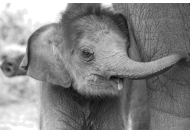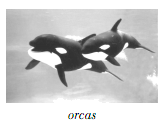
But there are a few exceptions, primarily among mammals (哺乳动物) that live in close social groups. Canadian zoologist Anne Innis Dagg described groups of langur monkeys in India in which older females lived with their daughters and grandchildren. The grandmother langurs have a particular job: they protect the group's babies against hurt from humans, dogs and other monkeys. Some female langurs even give their own grandchildren special treatment, cleaning their fur and stepping in when they play too roughly with other young.

Many whale species, too, travel with their families,including both grandmothers and grandcalves. In groups of sperm whales, according to Dagg, old females help babysit the group's young while their mothers dive (潜水) for food. Orca grandmothers often lead their family members and can live for many years after they stop reproducing. In 2015, scientists suggested that these elder orcas help their grandcalves through hard times, because they remember all the best places to find food.
Female elephants rule the whole family. Calves (幼崽) are typically born into groups led by their grandmothers, who can live to around 80 years old. The female elephants form close relationships, said Lahdenperä, and raise their young together. Lahdenperä found that the calves of young mothers were eight times more likely to survive if their grandmothers lived near them than if they didn't. When the calves' mothers were older and more experienced at raising babies, this beneficial “grandmother effect” disappeared even if the actual grandmothers were still around.
It isn't very clear how elephant grandmothers help their inexperienced daughters, said Lahdenperä. It is believed that they may help nurse their grandcalves. But Lahdenperä thinks that the more likely advantage is the wisdom a grandmother elephant has got during her long lifetime.
And what about grandfathers? Studies of humans in recent years have shown that a living grandfather can improve a person's mental health and well⁃being, said Lahdenperä.
But there are signs of that in the animal kingdom, she said. Male animals seldom socialize with their own children, let alone grandchildren. “Males are usually focusing on producing their own children and aren't providing so much care,” Lahdenperä said.
1. From Paragraph 3, we know that orca grandmothers _______.
| A.die after reproducing | B.teach the young to dive for food |
| C.have rich experience | D.enjoy travelling with grandfathers |
| A.the “grandmother effect” lasts long in the animal world |
| B.grandmothers shoulder great responsibilities in their families |
| C.animal grandfathers can improve grandcalves' mental health |
| D.most species treat their grandparents like human beings do |
| A.Animal grandparents are like human grandparents |
| B.Animal grandmas are born group leaders |
| C.Are animal grandmas given enough respect? |
| D.Do any animals know their grandparents? |
2 . Could the students from less developed areas in central and western China get the same educational chances as those in big cities in the east? Could the children in poor rural (农村) areas develop as well as those in rich cities? Maybe the answers were “No” in the past. But now, China is trying to change the situation.
In order to help rural students grow taller and stronger, China’s Nutrition (营养) Improvement Program started in 2011. According to the program, a lot more money was spent improving students’ meals. More than 36 million students from 134,000 primary and junior high schools in poor rural areas have benefited from the program. They are provided with healthy food like eggs and milk from Monday to Friday at school. And the result of a survey shows that the students in those areas are much taller and stronger than before.
It is true that there were differences between less developed areas and developed areas in education before. Recently, The Guideline for Popularizing High School Education (2017-2020) has come out. According to the guideline, above 90% students from all over the country will go to high schools by 2020. What’s more, the schools in central and western areas will get more support to improve their education.
Students from rural and poor areas also get more chances to receive higher education. A special college program makes it possible for more students from those areas to go to key (重点的) colleges and universities. The number will be increased by 10% in 2017.
With the guideline and the programs, we can expect a fairer and more balanced (均衡的) education in the future.
1. The number of 134,000 in Paragraph 2 is the number of _______ in poor rural areas.| A.the key schools | B.the poor students |
| C.the key colleges and universities | D.the primary and junior high schools |
| A.逃离 | B.获益 | C.受害 | D.赚钱 |
(=Para.(自然段) 1 =Para. 2 =Para. 3 =Para. 4 =Para. 5)
| A.;; | B.;; | C.;; | D.;; |
| A.Liu Xi, a student from Chongqing, can go to any high school if she wants to |
| B.Li Mei, a student from a western rural school, can get a bag of milk every day |
| C.Hu Jia, a 12-year-old rural student, will more easily receive high school education |
| D.Han Lei, a student from Beijing, will have few chances to go to key universities |



